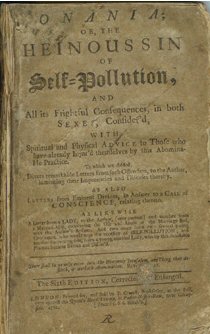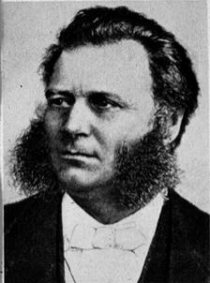Home Page
The latest articles, features and news.


All About...


Sponsored Links


Discussion Forums




Pecker Provisions


Condoms, lubes, pumps, stretchers, exercises, supplements, sports underwear and more.

Firefly Talks Dicks


Words of feminine wisdom about men's problems.

|
| | |
|

22 May 2006
When Circumcision Was The Cure For Everything
by Paul A.
As we've learned in the last few weeks, circumcision has a long and storied history. Originating in prehistory as a sacrificial rite, it became mandated for Jews under God's law and for Muslims under the rationale that Mohammed had it done and what's good for Mohammed is good for you too, Bub. Various attempts have been made over the centuries to apply a more logical rationale to the operation. Maimonides, the 12th century Jewish theologian argued that circumcision was necessary "to bring about a decrease in sexual intercourse and a weakening of the organ." A generation later, his enthusiastic follower, Isaac ben Yediah, went a step or two farther with this now famous missive about the perils of not being circumcised:
|
When a woman makes love to an uncircumcised man, she feels pleasure and reaches orgasm first. When an uncircumcised man sleeps with her and then resolves to return to his home, she brazenly grasps him, holding onto his genitals and says to him, "Come back, make love to me". This is because of the pleasure that she finds in intercourse with him, from the sinews of his testicles - sinew of iron and from his ejaculation - that of a horse - which he shoots like an arrow into her womb.
With the circumcised man it is different. He will find himself performing his task quickly, emitting his seed as soon as he inserts the crown. As soon as he begins intercourse, he immediately comes to a climax. The woman has no pleasure from him. She leaves the marriage bed frustrated. She does not have an orgasm once a year, except on rare occasions.
|
Yup, you read correctly. This was given as a rationale FOR circumcision. The logic is sound enough I guess: Sexual pleasure is bad. Foreskins promote sexual pleasure therefore foreskins are bad. And I suppose if you bought into the initial premise, you might not mind that you were leaving your wife high-and-dry to lust after some uncircumcised stud. It's a little thin but as rationales go it was pretty much the only one proffered for several centuries because, hey... no rationale was really needed. Circumcision was performed for reasons that stood outside of logic.
Enter medical science! Beginning in the 18th century the western world was awakening to the notion that not everything that happened was at the whim of God. Newton had demonstrated that the universe ran according to physical laws and the corollary to this was the notion that nature could, nay, should be manipulated. The first medical circumcisions were performed sporadically in the 18th century to remove syphilitic sores which tended to locate themselves on the foreskin. Beginning in the 19th century it was prescribed as a cure for phimosis, a condition, where the foreskin is unable to retract over the glans. Although we now know that a non-retractable foreskin is not abnormal in pre-adolescent boys; at the time it was seen as a pathological condition that had to be dealt with. In the 1830s circumcision became widespread, at least amongst the upper classes as a preventative and punitive measure aimed at controlling masturbation. While spanking the monkey is generally understood today as a natural and healthy means of relieving sexual tension, in the early 19th century it was regarded as one of the greatest evils to befall mankind.
 Throughout history, flogging the hog has never been highly regarded, but its demonization in the 19th century was positively psychotic. Some of this psychosis can be traced back to two 18th century publications, the anonymous 1716 tract entitled Onania - Or the Heinous Sin of Self-Pollution and Andre-David Tissot's Onanism: Or a Treatise Upon the Disorders produced by Masturbation: Or, the Dangerous Effects of Secret and Excessive Venery (I760), in which he attributed masturbation as the root cause of such diverse ailments as... you name it... pimples, hemorrhoids, tuberculosis, weak-mindedness and blindness.
Throughout history, flogging the hog has never been highly regarded, but its demonization in the 19th century was positively psychotic. Some of this psychosis can be traced back to two 18th century publications, the anonymous 1716 tract entitled Onania - Or the Heinous Sin of Self-Pollution and Andre-David Tissot's Onanism: Or a Treatise Upon the Disorders produced by Masturbation: Or, the Dangerous Effects of Secret and Excessive Venery (I760), in which he attributed masturbation as the root cause of such diverse ailments as... you name it... pimples, hemorrhoids, tuberculosis, weak-mindedness and blindness.
Once masturbation became established as health hazard numero uno it was a fairly small hop to employ circumcision to cure it. The Jews, who themselves had a long history of prohibition against masturbation (touching the penis in any manner including urination was discouraged), had long endorsed the inhibitory effects of circumcision on self-pollution. It is ironic that England, which only a generation or two earlier had passed the notorious Jew Bill restricting the practice of ritual circumcision, now began to embrace it � for reasons of health of course (read: morals).
But it wasn't until the late 19th century that circumcision became widely employed as a prophylactic measure to ensure that future health was not compromised. Some of this was grounded in real science. By the end of the century it was well established that circumcision was effective in reducing the risk of contracting various venereal diseases, particularly syphilis which was a scourge at the time. But no single factor was more crucial to the propagation of circumcision as a medical procedure than the tireless advocacy of one man. Christianity had St. Paul. Medical circumcision had Dr. Louis Sayre.
 Before 1870, Dr. Sayre (pictured) was a renowned orthopedic surgeon who had never thought about, let alone performed, a circumcision. Sayre's revelation came on February 9th of that year when he was called in to examine a 5 year old boy who was unable to straighten his legs or walk without assistance. The boy's current doctor assumed he was spastic and required surgery to cut the hamstrings. But upon examination, Sayre instead concluded the problem was not spasticity, but paralysis stemming from reflex neurosis. Reflex neurosis was an umbrella term to describe disorders that stemmed from what was called "nervous irritation". By the closing years of the 19th century it was clear that the body was a deeply interconnected system of systems, the nervous system in particular. It was widely believed that an irritation in one part of the nervous system could affect another. The notion was based on a misunderstanding of the mechanisms of the nervous system, but the idea was pretty advanced for a profession that just a few years earlier was bleeding patients with leeches.
Before 1870, Dr. Sayre (pictured) was a renowned orthopedic surgeon who had never thought about, let alone performed, a circumcision. Sayre's revelation came on February 9th of that year when he was called in to examine a 5 year old boy who was unable to straighten his legs or walk without assistance. The boy's current doctor assumed he was spastic and required surgery to cut the hamstrings. But upon examination, Sayre instead concluded the problem was not spasticity, but paralysis stemming from reflex neurosis. Reflex neurosis was an umbrella term to describe disorders that stemmed from what was called "nervous irritation". By the closing years of the 19th century it was clear that the body was a deeply interconnected system of systems, the nervous system in particular. It was widely believed that an irritation in one part of the nervous system could affect another. The notion was based on a misunderstanding of the mechanisms of the nervous system, but the idea was pretty advanced for a profession that just a few years earlier was bleeding patients with leeches.
Sayre was convinced the boy's paralysis was rooted in a nervous irritation somewhere else... but where? When Sayre learned the boy was suffering from a painful form of phimosis he was convinced this was the nub of the problem. So sure was Sayre in his diagnosis that he performed the circumcision in a lecture theatre. And he was vindicated. Within weeks the boy was able to walk without support. Sayre performed another circumcision a short while later on another patient with similar results. He became a proselyte for the idea of circumcision as a kind of cure-all. Had he been an undistinguished surgeon the idea may not have taken hold, but Sayre was a giant in his profession and his theories were taken seriously on both sides of the Atlantic. A rationale began to take shape for the idea of prophylactic circumcision. It was a modernistic conceit. Nature wasn't perfect. It could be improved upon. And doctors are nothing if not proactive.
And once the idea of neonatal circumcision became endorsed by the medical profession, it quickly spread. Even as the rationales that originally supported circumcision were discredited, others quickly took their place. For a time, circumcision was believed necessary because smegma was itself believed to be an infectious substance. When that theory went out the window circumcision was performed because it was shown to reduce the occurrences of penile cancer and urinary tract infections. And hey... better safe than sorry, right? In the 1876 version of Encyclopedia Britannica, circumcision was defined as quasi-sacramental Jewish rite. In the 1920s it was defined first as a medical procedure and only secondarily as a Jewish ritual. With the invention in the 1930s of the Gomco clamp, which allowed for a bloodless (if still excruciating) procedure, the road to universal circumcision was paved. By the mid 19th century the circumcision rate in America was over 90 percent. Even today, after its universal application has been largely discredited, prophylactic circumcision is being touted as a means of controlling AIDS in Africa and pro-circumcision advocacy groups are becoming established on the Internet. It would seem that once a practice is established, the rationales for it, however irrational, die hard.
|
|